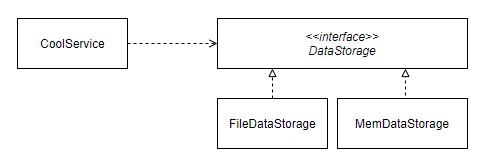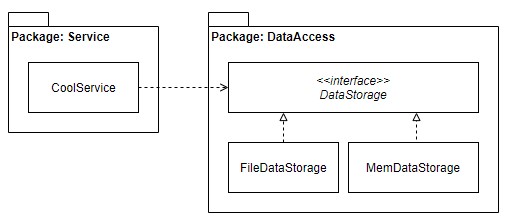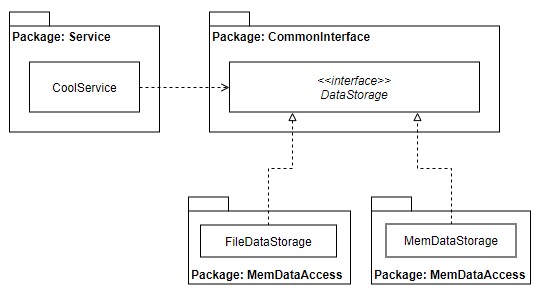Dependency and decoupling
1. Simplest dependency graph
Let’s say we’re building an awesome app, but at first, we just have 2 objects (classes): CoolService and SimpleDataStorage.

SimpleDataStorage provides methods to read/write some data from files in local disk.
CoolService uses methods provided by SimpleDataStorage to access data, and also does other cool stuffs.
So, CoolService has SimpleDataStorage as its dependency, in constructor like this:
class CoolService {
public CoolService(SimpleDataStorage simpleDataStorage) {
this.dataStorage = simpleDataStorage;
}
}
We have simple setup like this:
SimpleDataStorage dataStorage = new SimpleDataStorage();
CoolService service = new CoolService(dataStorage);
Things work well for now.
2. Multiple implementations
One day, we see that accessing data from local file is too slow, we want to put data on memory.
We can modify the code in SimpleDataStorage to handle in-memory data.
Or more careful, create new class MemDataStorage, and keep the SimpleDataStorage in case we want to
revert back to use local file storage.
But, we still need to change CoolService:
class CoolService {
public CoolService(MemDataStorage memDataStorage) {
this.dataStorage = memDataStorage;
}
}
We will try to keep MemDataStorage to has same method signature as SimpleDataStorage to minimize code
change inside CoolService. But at the very least, we still have to change the constructor.
Here CoolService depends on the concrete implementation (MemDataStorage or SimpleDataStorage).
And we violate the D in SOLID. You can see the inconvenience
where replacing multiple implementations.
3. Depend upon abstractions, not concretions

Here we introduce new interface DataStorage, defines generic behavior for data access.
We also have 2 implementations of that interface: FileDataStorage and MemDataStorage.
These classes implement the behavior of interface in specific way (File vs Mem)
Now, the CoolService depends on the interface (abstraction), not concrete implementation:
class CoolService {
public CoolService(DataStorage dataStorage) {
this.dataStorage = dataStorage;
}
}
And the setup:
DataStorage dataStorage = new FileDataStorage();
// Or
DataStorage dataStorage = new MemDataStorage();
CoolService service = new CoolService(dataStorage);
Whenever we want to change implementation, just swap it out in the setup code, without touching the code
inside CoolService.
Great! Now we achieve the loose coupling dependence.
4. Even looser: packages
Let’s say, these components CoolService, FileDataStorage and MemDataStorage become bigger and bigger,
with a lot of complex logic.
We decide to split into multiple teams, 1 for each component. Dont want to share same code repo, so we also split the system into packages. This is the draft design:

Here we split into Service and DataAccess package. But this is not good enough:
- At the package level, Service still depends on implementation (
FileDataStorageandMemDataStorage) FileDataStorageandMemDataStoragestill share same package
So, split even more:

Here we achieve our best decoupling:
- Each team can work on each component (package) independently
- All teams agree (and depend on) the contract: the package CommonInterface
- The contract is defined by highest level design, all relevant component rely on it
5. Wiring things up
Until now, all are just at the design time.
You may ask how CoolService can call the implementations
(FileDataStorage and MemDataStorage) at runtime if it doesn’t depend on them?
Here comes: the host app, a separate component which has access to all components. For each interface
(like DataStorage), it will choose the concrete implementation (FileDataStorage or MemDataStorage)
and construct it. Then use it to construct the CoolService, and so on.
When the dependency tree is ready, it then run the app, handle requests…etc…